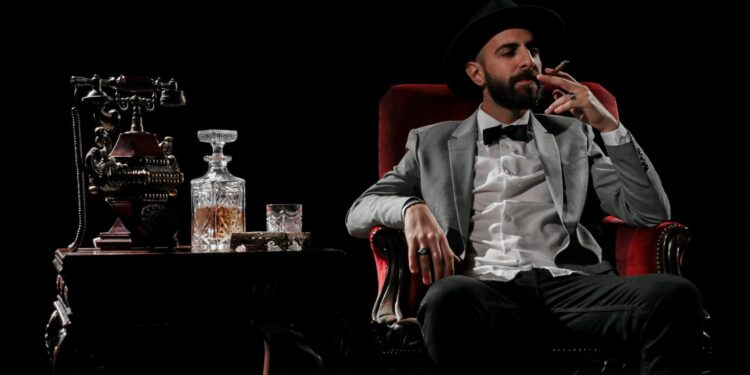Peaky Blinders is a popular British drama set in Birmingham in post-WWI England. The series tackles crime, class, and organized crime themes as it follows the Shelby crime family climbing to power in the industrial city.
But what is the true story behind the series? First, let’s look at Peaky Blinders’ origins and the fascinating history behind them.
The Real Peaky Blinders Gang
Peaky Blinders were a real gang in Birmingham, England, during the late 19th century and early 20th century.
The gang’s name is believed to have been derived from their practice of sewing razor blades into the peaks of their flat caps, which they used as weapons in fights and robberies.
The peaky blinders’ criminal activities included racketeering, blackmail, robbery, and illegal gambling.
The gang’s leader, Thomas Shelby, is believed to have been inspired by a real person named Billy Kimber, a prominent figure in the Birmingham underworld in the early 1900s.
Despite their notoriety, the peaky blinders’ reign was short-lived, and they were disbanded in the 1920s.
The BBC television series “Peaky Blinders” is loosely based on a real-life gang, reimagining their history and portrayal of their leader, Thomas Shelby.
The show’s fictionalized account of the gang’s history has sparked renewed interest in their story and the history of organized crime in Birmingham during the early 20th century.
The historical context of Peaky Blinders
Peaky Blinders is a British crime drama television series set in Birmingham, England, during
the aftermath of World War I. The show is loosely based on a real 19th-century urban youth gang. The real Peaky Blinders were active in the late 19th and early 20th centuries and were known for their signature style of flat caps with razor blades sewn into the peak, which they would use as weapons. In addition, the gang was involved in illegal activities such as robbery, gambling, and protection rackets. The Peaky Blinders were eventually disbanded, but its legacy lived on and inspired the popular television series.
The show fictionalized the gang’s story and pitted them against rival gangs, corrupt politicians, and law enforcement agencies. Peaky Blinders garnered critical acclaim and a loyal fan base for its compelling storyline, gritty realism, and superb acting performances.
The first Peaky Blinders season and its inspiration
The first season of the Peaky Blinders series is inspired by the real-life gang Peaky Blinders, active in Birmingham, England, during the late 19th and early 20th centuries.
The gang was notorious for their violent crime spree, including robbery, extortion, and assault with razor blades sewn into their hat peaks.
The show takes creative liberties with historical accuracy but stays true to the overall atmosphere and feel of the era.
The series also explores themes of class struggle, political corruption, family dynamics, and loyalty, adding to its appeal.
Although the real Peaky Blinders gang ceased to exist over a century ago, the show’s popularity has led to a resurgence of interest in the gang’s history and legacy. The show has since become a global phenomenon with a large fan following.
Peaky Blinders Online Sa Prevodom
The Peaky Blinders, a notorious street gang that had its roots in Birmingham, England, has earned its place in history as one of the most notorious gangs of the late 19th and early 20th centuries. Yet throughout the years, the Peaky Blinders have remained active. Over time, the gang has evolved, embracing new technology and facing new challenges.
This article will delve into the history and evolution of the notorious Peaky Blinders.
The impact of the Birmingham Boys
The Birmingham Boys was a notorious criminal gang in Birmingham, England, in the early 20th century. They are widely believed to be the inspiration behind the Peaky Blinders, a team that rose to infamy during the same period.
The Peaky Blinders were known for their signature style, which included wearing flat caps with razor blades sewn into the brim. The gang operated in the city’s slums and gained a reputation for brutality and violence.
Today, the history of The Peaky Blinders continues to captivate the public imagination, thanks in part to the success of the popular TV show of the same name. While the show takes many creative liberties with the historical record, it remains a fascinating look at the lives of those who lived during that era.
Pro tip:If you want to learn more about the history of The Peaky Blinders, it’s worth checking out books and documentaries that explore the topic in greater depth.
The Rise and Fall of Alfie Solomons
The rise and fall of Alfie Solomons mark a pivotal point in the evolution of the Peaky Blinders series, based on the true history of Birmingham’s criminal gangs in the aftermath of World War I.
In the show, Alfie Solomons, played by Tom Hardy, is a Jewish gang leader who forms an uneasy alliance with Tommy Shelby, the leader of the Peaky Blinders. Throughout the series, Alfie’s rise to power and eventual betrayal of the Shelby family highlights the complex interplay between criminal organizations, political leaders, and law enforcement officials.
The Peaky Blinders series draws inspiration from the real-life exploits of the Birmingham gang, which gained notoriety for their distinctive dress and violent tactics in the early 20th century. The show’s attention to historical detail and nuanced characters has helped to make it a standout in the crowded field of period dramas.
Pro tip: If you’re a fan of Peaky Blinders, consider delving into the history of Birmingham’s gangs to deepen your appreciation of the show’s carefully crafted world.
The fourth and fifth Peaky Blinders seasons and their historical references
Peaky Blinders is a British historical crime drama premiered in 2013 and has since become a fan favorite. The fourth and fifth seasons of the show delve deeper into the historical and political context of the time, providing references to real-life occurrences and individuals.
The fourth season, set in 1925, centers around the aftermath of the 1924 Birmingham Boys’ gang war and the rise of the fascist movement in Europe. The season also introduces the character of Luca Changretta, an Italian-American gangster seeking revenge on the Shelby family for killing his father.
The fifth season, set in 1929, explores the Wall Street Crash of 1929, the economic instability that followed, and the rise of Oswald Mosley and his British Union of Fascists. The season also features the character of Gina Gray, a member of the American Mafia and Michael Gray’s wife.
While Peaky Blinders is a fictional story, it often references real historical events and figures from the period to create a vivid and engaging portrayal of 1920s England.
The Cultural Impact of Peaky Blinders
Peaky Blinders is an English crime drama television series that has created a huge cultural phenomenon. It tells the story of the formidable Shelby Crime Family, focusing on Tommy Shelby and his Peaky Blinders gang pursuing power and wealth in post-World War One Birmingham. Since its debut in 2013, the series has greatly impacted popular culture, inspiring music, fashion, and more.
In this article, we’ll explore the history and cultural impact of the Peaky Blinders.
The resurgence of interest in 1920s fashion
Peaky Blinders, the British television series set in the 1920s, has sparked a resurgence of interest in 1920s fashion. The show’s costume designer has created a unique style that reflects that era’s iconic fashion trends, such as men’s flapper suits and women’s drop-waist dresses. The show’s character, Thomas Shelby, played by Cillian Murphy, has become synonymous with the 1920s vintage style. The series also depicts the culture of post-World War I England and the lives of the Shelbys, a ruthless gang family in Birmingham.
The history of Peaky Blinders dates back to the late 19th and early 20th centuries when the real-life Peaky Blinders gang terrorized the streets of Birmingham. Their distinctive dress code, including flat caps with concealed razor blades, still captures the public’s imagination today.
The show’s popularity has led to a renewed interest in 1920s fashion, from flapper-style dresses to double-breasted suits, and the fashion industry has taken notice by incorporating these styles into their collections.
Pro Tip:Watching Peaky Blinders is an excellent way to learn about 1920s fashion and history while enjoying a captivating TV show.
The tourism boom in Birmingham
The popular TV show Peaky Blinders has had a significant cultural impact on Birmingham, contributing to a tourism boom in the city. However, the show is not just a fictional crime drama; it is based on a real-life gang that operated in Birmingham during the late 19th and early 20th centuries.
The Peaky Blinders were known for their distinctive style, including flat caps with razor blades sewn into the brim and their illegal activities involving gambling, robbery, and violence.
The gang was eventually disbanded in the 1920s, but their legacy lives on through the TV show and in Birmingham’s cultural and historical fabric.
Today, visitors to the city can take a Peaky Blinders tour, visiting real-life locations from the show and learning about the fascinating history of this infamous gang.
The influence of Peaky Blinders on other TV shows and films
In recent years, Peaky Blinders has made a significant cultural impact on the world of TV shows and films, inspiring creators across the industry to take notice of its unique style and storytelling. In addition, the historical context of Peaky Blinders, set in post-World War I Birmingham, has also piqued the viewers’ interest and inspired a newfound curiosity for the history of the real-life gang.
The show has influenced several other shows and films with similar themes and styles, including Taboo, Gangs of London, and Boardwalk Empire.
As for the history of Peaky Blinders, the gang was a criminal organization in Birmingham in the late 19th and early 20th centuries, known for their distinctive dress and violent turf wars. The Peaky Blinders were named for the razor blades sewn into the peaks of their flat caps, which they used as weapons.



















